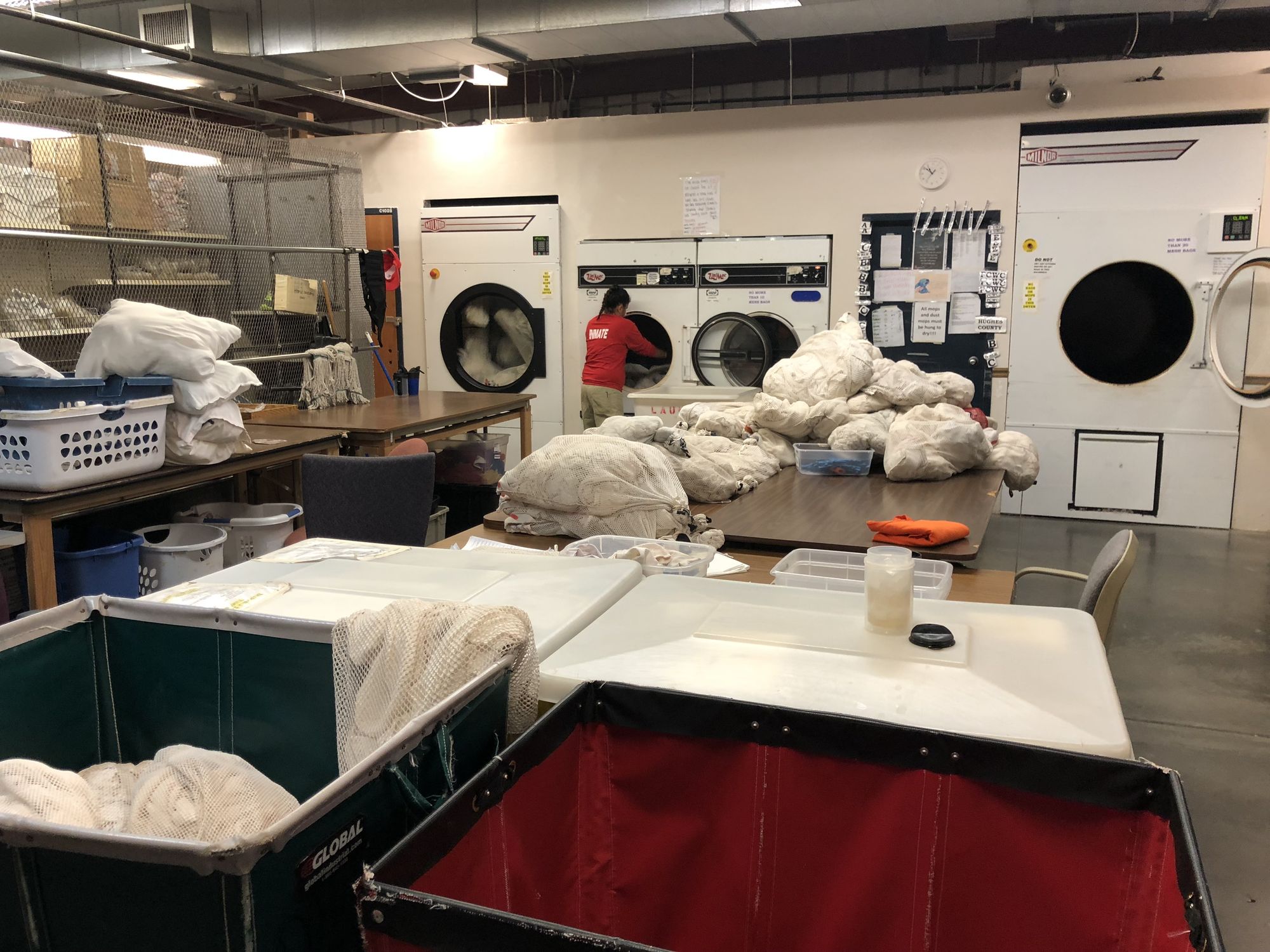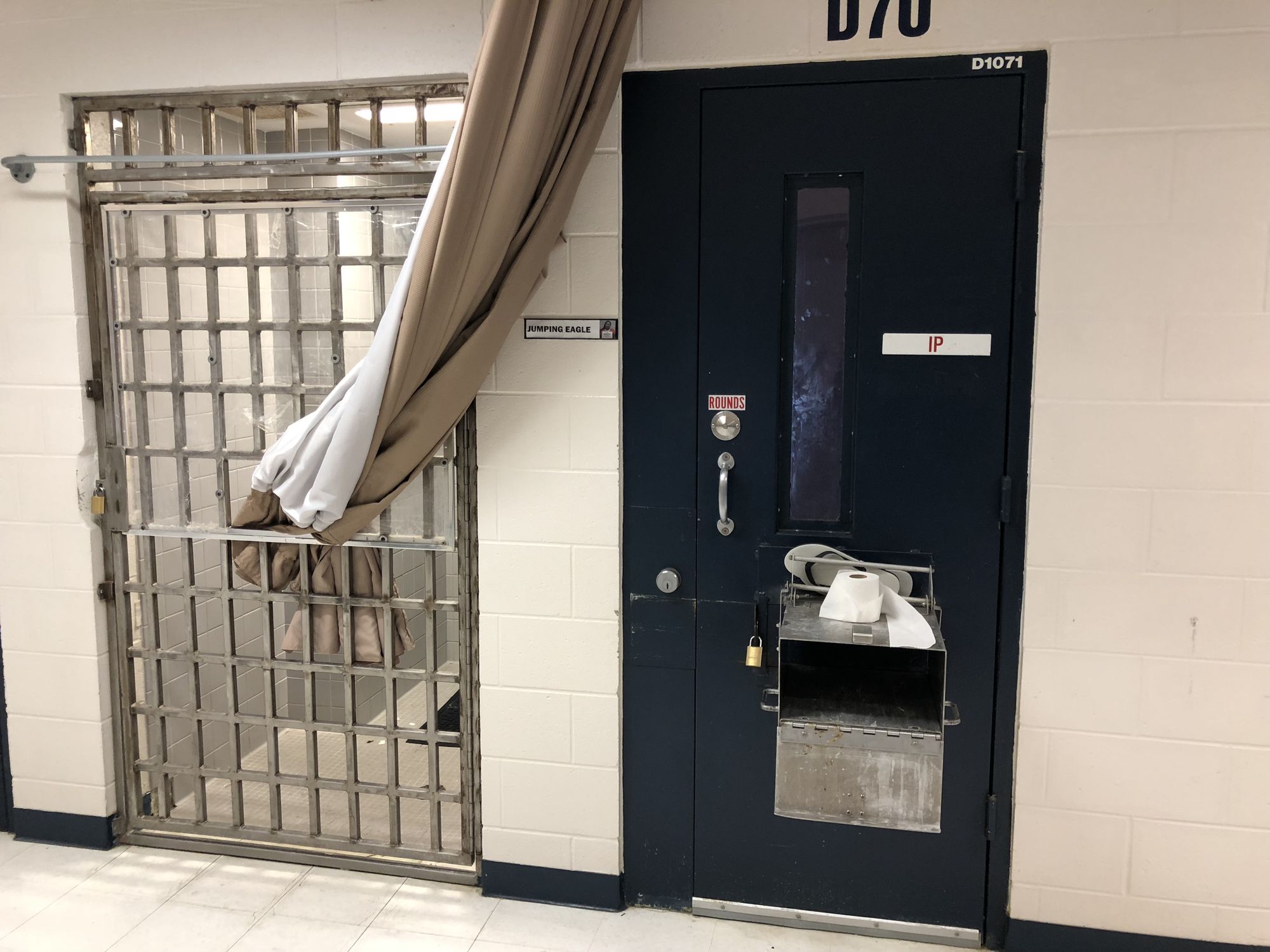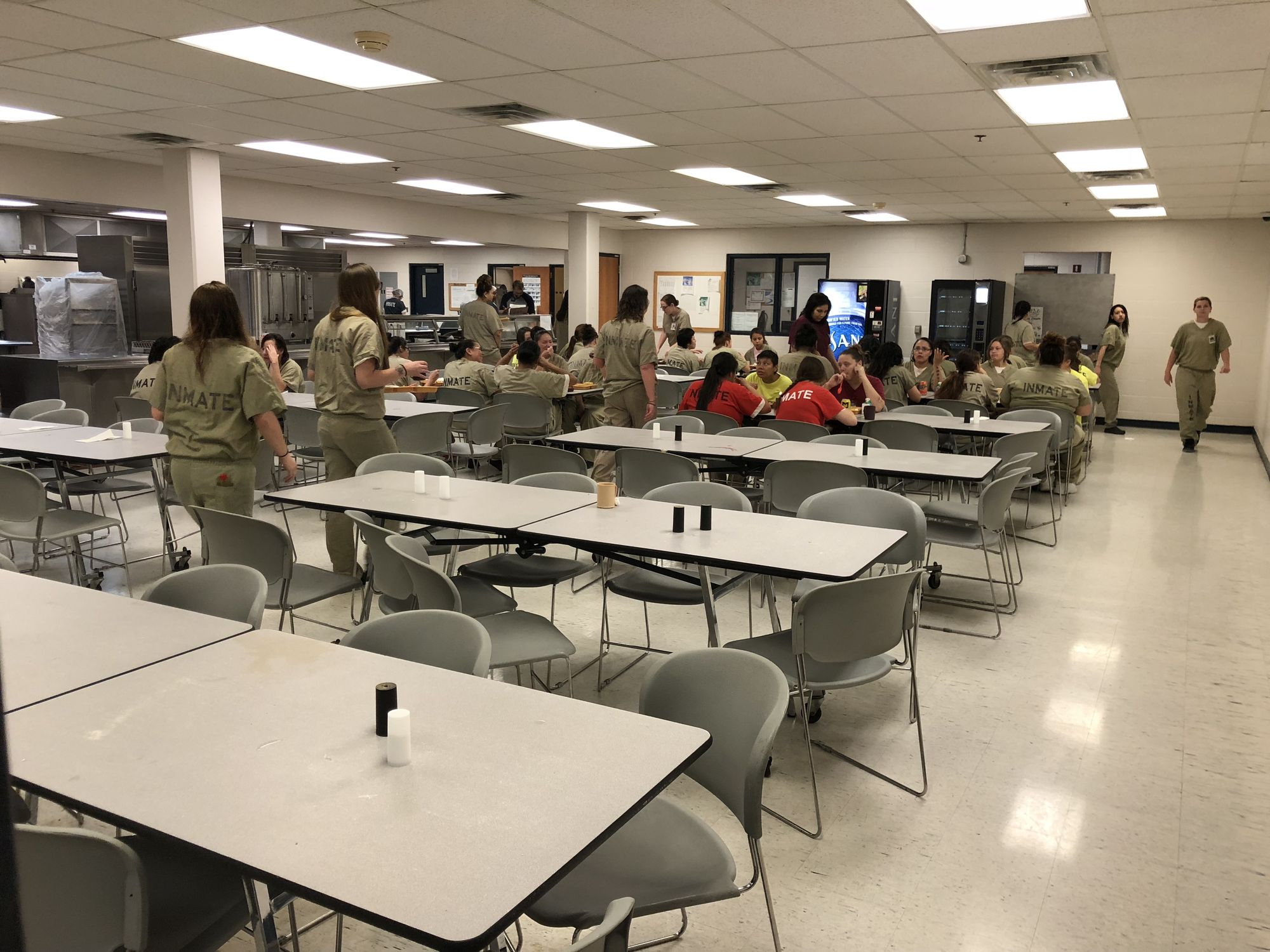PIERRE, S.D. – The rolling barbed wire atop tall chain-link fences, the thick metal and glass entrances doors, and the cell blocks and entry points under constant guard by officers and cameras are all indicators of the intense security at the South Dakota Women’s Prison in Pierre.
Once inside those walls and fences, however, a different view emerges of the state’s only prison for women.
Not unlike a huge college dormitory, women mostly in their 20s and 30s walked casually and unguarded through wide hallways on a recent September morning to one destination or another. Walkways and housing units were fairly quiet, with only a low din of women’s voices or occasional laughter to be heard. Inside locked cell blocks, women sat in common areas at metal tables in small clusters or by themselves, reading books, chatting or using their I-pads.
At a motivational presentation by former meth addicts in the gymnasium, where baseball gloves hung on hooks and a tray of basketballs rested against a back wall, several dozen women sat on metal folding chairs listening or occasionally applauding. Some held drinks in bottles that looked like travel mugs. When they needed to use the restroom, they made their way to the back of the gym and patiently waited in line without incident.
“Generally, it’s a much more relaxed atmosphere than at our men’s prisons,” said Michael Winder, the spokesperson for the state Department of Corrections who led a South Dakota News Watch reporter on a full tour of the prison in September.
The tour was led by Winder, Deputy Warden Darren Berg and new Warden Wanda Markland, who became warden in July after serving as an assistant warden at a prison in Tennessee.
About 85 percent of inmates at the prison are sentenced for non-violent crimes, and the average length of stay is about eight months. Roughly two-thirds of women inmates are convicted of drug-related crimes, Winder said.
Sitting idly, killing time or sleeping the day away are certainly part of the daily routine for many of the roughly 490 inmates in Pierre who are serving sentences both as punishment and to keep society safe.
But on any given day, the women’s prison also bustles with activities designed to help reform inmates, give them job skills, provide treatment for addiction, and keep basic prison functions running smoothly.
Down the hall from the gym, a private industry is benefitting from inmate labor and teaching job skills. In a small room, a handful of inmates sat at sewing machines or cutting tables and earned minimum wage as they assembled star quilts for a Martin company called Badlands Quilting.
Several other work programs are underway at the prison. In one effort, inmates aid in archiving of South Dakota newspapers, municipal documents and death certificates on microfilm under the direction of the State Archives. Inmates also learn eyeglass repair skills as part of a work program run by the Lions Club to provide glasses to the needy. In another work project, inmates helped assemble supply kits for new mothers enrolled in the state Right Start program. In the laundry room, inmates clean and dry linens and clothing for the prison but also for some other state agencies in Pierre.

Levels of security
The prison has the gym and a large fenced yard outside with a baseball diamond and circular walking path. Inmates in good standing receive about four to six hours of recreation time per day.
Cell blocks where inmates sleep and spend most of their time are categorized and controlled based on the level of risk the inmates pose, with behavior, compliance and custody level the main factors. Inmates wear matching shirts and pants of different colors, with the color indicating their custody and security level.
In lower-security housing units, a series of metal tables and benches are positioned in the common areas, while six inmates per cell sleep in bunks up to three levels high that are enclosed only by a curtain. Common shower areas with stalls and curtains are in the middle of the cell block. Showers are located at the far end of a separate, detached minimum-security housing unit that looks and feels much like a portable classroom building found at many public schools. Women stay in small cells with three-level bunks and curtains instead of doors.
Higher-security units have the same cell block arrangement but with cells that house up to three inmates and are locked each night or when inmate movements must be controlled by metal doors with a small window.
In the highest-security unit, known as A Block, inmates who are a risk to themselves or others or who have had disciplinary violations are held alone in locked cells where they can watch TVs positioned atop a central tower and listen through head phones inside their cells. When let out of their cells, those inmates may be kept out of the common area and instead be held inside a chain-link fenced room where they can be segregated from others. A single shower and restroom unit has a curtain for privacy but can be readily monitored by officers. Though inmates can be held in cells alone for a time, there is no long-term solitary confinement at any South Dakota prison, Winder said.
Inmates of highest risk may be transported through the prison or into the fenced yard outside in handcuffs and belly chains. Only about 40 inmates are classified at the maximum-security level.
As Warden Markland strolled through A Block on a recent day, several inmates vied for her attention and made requests for changes in their treatment or living supplies. Markland approached their cells and told them she would take their requests under advisement.
From an elevated officer station with glass walls and a view of all four main cell blocks, correctional officers use cameras, radios and other technology to track inmate movements and maintain order.
Inmates move under guard in shifts to the dining hall where they are fed three meals a day. During time in the cell blocks, inmates who have shown good behavior can use tablet computers provided to the corrections system as part of an agreement with a telecom firm. Inmates cannot access the internet, but can use the computers to send and receive email, make phone calls or download books or music if they have money to pay for use. Inmates can receive money for computer use or commissary items from people outside the prison or from the 25 cents-an-hour they make for working inside the prison.
Just as with communal phones in the cell blocks, all messaging or calls in or out of the prison are monitored and reviewed for security by officers, Markland said.
Each cell of the four main cell blocks has two or three cameras to monitor activity, and all doors are checked every half hour. Inmates on a mental health or suicide watch are checked by officers every seven to 15 minutes. Correctional offices perform a full “shakedown” or inspection of one area of the prison each week in which they search cells and work areas and use dogs to hunt for contraband.
Throughout the day, as they monitor and control inmate behavior, officers use a computerized wand called “the pipe” to pass over numerous checkpoints where a device on the walls and at doors emits an electronic signal that is recorded by the wand. The signals provide accountability over both inmates and officers, Markland said, by proving that areas and inmates were checked as required, but by also recording which officer was present at a certain time and place in case a dispute arises.
Inmates are allowed to see visitors on Fridays, weekends and holidays. Before being allowed in, visitors must sit in a chair and be sniffed by contraband dogs that can smell drugs, cell phones and tobacco. Officers inside the walls carry pepper spray but no firearms; an armory is located off site in case of a major uprising.

Pregnancies and time with families
Some elements within the prison are unique to women. At any given time, about 17 to 20 inmates are pregnant and receive visits from obstetricians and gynecologists. Births occur at a local hospital, typically not under guard, and new mothers are given 30 days to bond with their babies before relinquishing custody to family members or the state, Berg said. Inmates must pay for their own diapers, formula and other infant needs, he said.
As a benefit for mothers who display good behavior, inmates can sign up for the PACT House program in which they can spend a 24-hour visit with their child age 12 or under in a housing unit separate from the main prison. The Parents and Children Together House looks like a typical apartment (except for walls brightly painted with murals of children’s TV and book characters), with a kitchen, laundry, living room and bedrooms. Inmates can play with their child, cook and clean for them, and sleep in the same house as a way to bond during their incarceration.
As with any institution, drama does occur inside the women’s prison, said Berg, the assistant warden, “Most of them get along, though you always have a problem child or two and then you try to get them to change their ways,” Berg said.
Unlike at men’s prisons where physical altercations occur with more frequency, Berg said most of the tension at the women’s prison is due to relationship drama.
“There are occasional fights, but it’s not a movie and it’s not HBO,” Berg said, referring to popular prison shows such as “Orange is the New Black” where violence, drug use and corruption are common. “The women tend to be more relationship dependent, and they tend to bond more deeply than men.”
Throughout their stay, women inmates who follow the rules are given opportunities to undergo drug treatment programs, parenting classes, GED high-school equivalency classes and participate in job-readiness programs.
Berg said the overall tenor of the prison is generally one of acceptance and cooperation by inmates serving out their sentences and also trying to better themselves and gain rewards such as early release.
“It’s all about reducing recidivism,” he said. “We don’t want to see them back here.”





